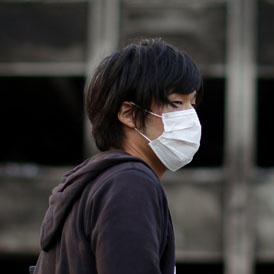Another earthquake rocks Japan
 Alex Thomson
Chief Correspondent
Alex Thomson
Chief Correspondent
A 7.4 magnitude earthquake has struck off the north east coast of Japan, as the region struggles to recover from last month’s devastating quake and tsunami. Alex Thomson speaks to people in Japan.

A strong 7.4 magnitude earthquake has rocked northeast Japan just weeks after a quake and tsunami devastated the area. A tsunami alert was issued after the tremor hit off the coast of Miyagi prefecture at 11.32pm local time.
The epicentre was 40km below the seabed, according to the Meteorological agency. Local people were initially advised to head to the high ground amid fears that a 1m-high wave was about to hit the coast, but the tsunami warnings were later lifted, according to state broadcaster NHK.
NHK broadcast footage of buildings shaking in Tokyo during the latest quake.
Another big one. Everyone OK. Power down so back to life on batteries. Michael Sato, in Japan
Michael Sato, a farmer from Iwate prefecture, who wrote an article about life in the shadow of Japan’s nuclear crisis after the quake for Channel 4 News, gave his immediate reaction to the quake.
He said: “Another big one. Everyone OK. Power down so back to life on batteries. Felt like a 7 here.”
Fukushima fears
Nine engineers working at Tokyo Electric Power Co’s Fukushima Daiichi nuclear power plant, which was left leaking radiation after last month’s disaster, were evacuated, the company said.
But there were no signs of damage at the reactor, which was left leaking radiation after last month’s disaster and is being cooled with water and nitrogen. A spokesman said: “We have looked into any issues with the facilities and our personnel and have verified that everything is all right.
“As for reported injuries, there were two workers near reactors One and Two and then also seven workers near the intake. They have not been injured and they have all taken shelter in our seismic resistant building.
Read more: Special Report - Japan: tsunami to nuclear crisis
“We are continuing to inject water, or we are continuing the injection operation at reactors One, Two and Three. So water injection is continuing at these three reactors without any issue. As for reactor number One, where nitrogen has been injected, we have seen no variance in the parameters.”
March earthquake and tsunami
More than 12,000 people have been confirmed dead after a magnitude 8.9 quake struck 231 miles northeast of Tokyo on March 11. Within an hour a tsunami wave more than 20m high in places had hit Japan’s northeast coast.
Shortly before the news of the latest earthquake, the UN atomic agency said there were signs that the situation was stabilising at Fukushima but the situation remained grave.
Denis Flory from the International Atomic Energy Agency said: “Our estimation of the situation at the Fukushima Daiichi nuclear power plant remains very serious although there are early signs of recovery in some functions such as electrical power and instrumentation.”